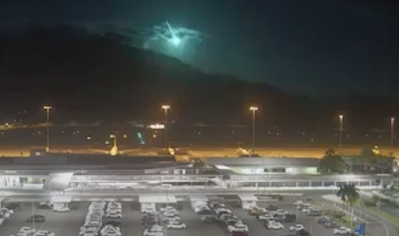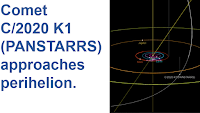A bright fireball seem over northern Queensland on 20 May 2023 has been declared to have been the largest meteor seen over Australia since records began in 1988. Planetary scientist Ellie Sanson of the Desert Fireball Network at Curtin University made the conclusion after examining satellite data of the meteor's passage provided by NASA. The satellite images revealed the object was travelling at about 28 km per second when it exploded, about 29 km above the town of Croydon. This implies that the object was about 3.5 m in diameter, and would have had a mass of about 8 tonnes.
A fireball is defined as a meteor (shooting star) brighter than the planet Venus. These are typically caused by pieces of rock burning up in the atmosphere, but can be the result of man-made space-junk burning up on re-entry. In this case many witnesses have described the object as being green in colour, probably implying an iron-nickel composition. Since the object exploded less than 35 km above the ground, it is thought highly likely that material from it will have reached the ground, and scientists from Curtin University are planning to organise a search of the object, along with researchers from other universities and members of the general public.
Objects of this size probably enter the Earth's atmosphere several times a year, though unless they do so over populated areas they are unlikely to be noticed. They are officially described as fireballs if they produce a light brighter than the planet Venus. The brightness of a meteor is caused by friction with the Earth's atmosphere, which is typically far greater than that caused by simple falling, due to the initial trajectory of the object. Such objects typically eventually explode in an airburst called by the friction, causing them to vanish as an luminous object. However, this is not the end of the story as such explosions result in the production of a number of smaller objects, which fall to the ground under the influence of gravity (which does not cause the luminescence associated with friction-induced heating).
These 'dark objects' do not continue along the path of the original bolide, but neither do they fall directly to the ground, but rather follow a course determined by the atmospheric currents (winds) through which the objects pass. Scientists are able to calculate potential trajectories for hypothetical dark objects derived from meteors using data from weather monitoring services.
See also...
Follow Sciency Thoughts on Facebook.
Follow Sciency Thoughts on Twitter.








